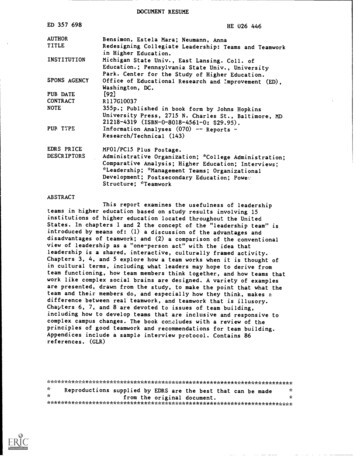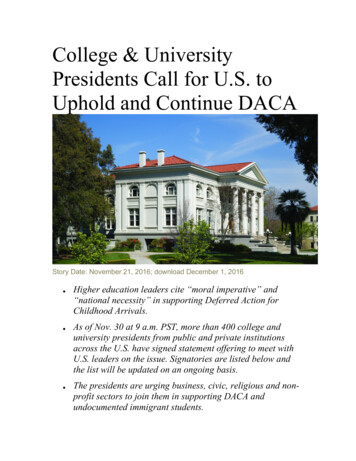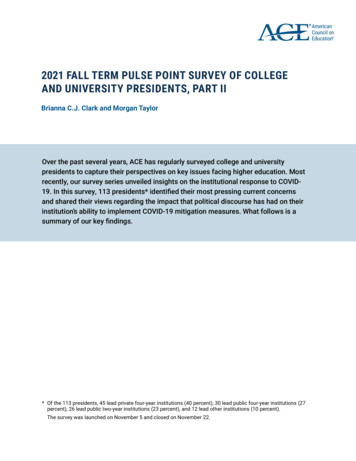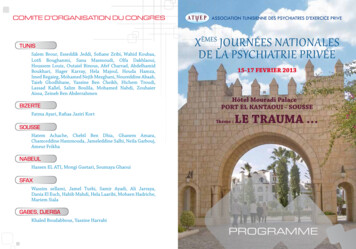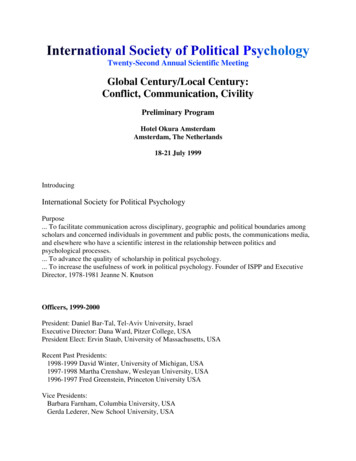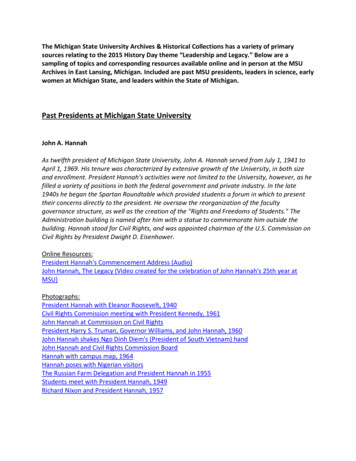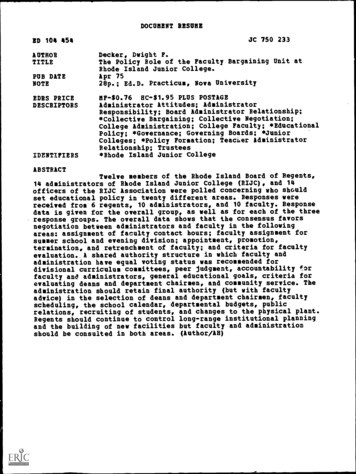
Transcription
NO. 1, 2021U.S. Presidents &Science: A RetrospectiveAlso Featured:Strategies for a More Sustainable LabOperating with Confidence in the Face of UncertaintyIn Support of ReproducibilityThis issue ofLab Reporter is sponsored by
CONTENTS24COVER STORYU.S. Presidents& Science:24A Retrospective44Strategies for a MoreSustainable Lab10Operating with Confidence in32the Face of Uncertainty32In Support of Reproducibility101212Check out more great contentfrom the sponsor of this issue ofLab Reporter: AnsellNote: To check pricing, please sign in to your account.Supplier and Other Trademarks: Airo, Ansell, AnsellGUARDIAN, AquaPur, Avantor, BAKERBOND, BINDER, BioSyn, BUCHI, BucketBinder, Burdick & Jackson, Comfort, Cubitainer, Decon, Dentec, Echo, Energy Star, EOS, Erlab, EZ-Fit,EZporator, Fortis500, FreeFlow, Gilson, HandPRO, Heidolph, Honeywell, Hourglass, Ingenio, J.T.Baker, Kimberly-Clark Professional, KNF Neuberger, LabChem, Labconco, LABOPORT, Medicom, MegaWringer, Metro, METTLER TOLEDO,Microban, Micronova, MilliporeSigma, Mirus Bio, MyCart, Nasco, Neutrodine, Peroxigen, Pipetman, PROchievA, Protector, Rotavapor, SafeMask, Sonoco, Starsys, ThermoSafe, TransIT, Unisorb, Whirl-PakTrademarks of Thermo Fisher Scientific: Fisher Scientific, Fisherbrand, Isotemp, Lab Reporter, Lipofectamine, Nalgene, Orion, ROSS, Sure-Flow, Thermo ScientificFor trademark ownership, see fishersci.com/trademarks.CONTACT US: United States: 1-800-766-7000 fishersci.com Canada: 1-800-234-7437 fishersci.ca
Lab Reporter provides quick and easy access to today’scutting-edge products and trusted solutions for all of yourscientific research and applications.SUPPLIER ARTICLES6 The Promise of12 Staying Agile:Honeywell Research ChemicalsAnsell18 Filtered Fume Hoods:20 Scientist to Scientist:A Manufacturer’s PerspectiveOligos in MedicineA Simple SolutionLabconco15 Three Pillars ofGlove Safety: Protection,Precision, and ComfortKimberly-Clark ProfessionalSustainability in LabPlastics21 Ergonomics FosterEffective CleaningMicronovaThermo Scientific38 Selecting the BestTransfection MethodMirus BioSUPPLIER PRODUCT GUIDEAnsell AnsellGUARDIAN Services. 14Fisherbrand Isotemp Shake Touch. 35KNF Neuberger LABOPORT Vacuum Pumps. 27Avantor J.T.Baker Resins. 7Fisherbrand Ultrasonic Cleaners. 29LabChem Conductivity and pH Standards. 8BINDER Simulation Chambers. 29Fisher Scientific Help and Support. 30Medicom Face Masks. 16BUCHI Rotavapor R-220 Rotary Evaporators. 28Fisher Scientific Safety Specialists. 37Metro Antimicrobial Furniture. 23Decon AquaPur Purified Water. 22Gilson Pipetman L Pipettes. 34METTLER TOLEDO Fisher Scientific Buck . 23Dentec Safety N95 Reusable Half-MaskHeidolph H-Genie Hydrogen Gas Generators. 28MilliporeSigma EZ-Fit Filters and Manifolds. 30Honeywell Research ChemicalsNasco Whirl-Pak Sampling Bags. 34Respirators. 17Fisherbrand Cryogenic Storage Labels. 36Fisherbrand Disposable Face Masks. 31Fisherbrand Glassware. 35KF Titration Chemicals. 9Hourglass InternationalHandPRO Fortis 500 Gloves. 17This publication was printed on recycled paper.Visit fishersci.com/labreporteror fishersci.ca/labreporter tosubscribe for free.OHAUS Analytical Instruments. 27SONOCO ThermoSafe EOS Shippers. 36Thermo Scientific Testing Workflows. 26
4LAB REPORTER A Fisher Scientific Publication
Strategies for a MoreSustainable LabBy Kevin RitchartWhile many people have adopted a more sustainable lifestyleat home, the practice of creating and maintaining sustainablehabits in the lab is still a work in progress.conservation opportunities, lab managers can shift the cultureof their lab toward a more sustainable approach. And astraightforward place to start is with waste.Studies have found that laboratory buildings consume 10times more energy and about four times more water than officespaces. Along with the increased power and water needs, theprevalence of single-use plastics also contributes to lab waste.While the general definition of waste is anything that’s left afterrecycling, reuse, and composting, the lab definition includesitems that are not being used to their full potential. This canmean purchasing unnecessary products, holding on to productsthat aren’t being used, and using existing resources in awasteful manner.Scientists worldwide have become more aware of this growingproblem in recent years, and they’re taking a closer look athow they work in the lab and what can be done to reduce theirenvironmental impact. Lab personnel are engaged in efforts tobecome more sustainable and join the “green lab” movement.By making sustainable big-picture decisions, lab managerscan help ensure their facility is doing its part to have a positiveimpact on the environment.Check the LabelIn North America, the process of identifying more sustainableproducts for your lab is made easier by the Energy Star andACT labels. Energy Star is an energy-efficiency designation thatwas created by the U.S. Environmental Protection Agency andthe U.S. Department of Energy to highlight equipment thatmeets certain standards.While most people are familiar with purchasing Energy Starcertified appliances for their homes, these designations havenow reached the lab. Products like ultra-low-temperaturefreezers now carry Energy Star ratings to aid lab managers intheir purchasing decisions.The ACT label is an econutrition designation that compareslaboratory products based on the environmental impact oftheir manufacturing, daily use, and disposal. The ACT labelis independently verified and designed to help scientistsmake more informed purchasing decisions based on theirsustainability goals.Sustainable StrategiesIn addition to using sustainable products, there are a numberof strategies for making labs more sustainable. By increasingawareness of their lab’s environmental impact and identifyingKevin Ritchart is a Fisher Scientific staff writer.By following these strategies, labs can reduce the amount ofwaste they’re creating:Consider shared equipment. Consider whether it’s possibleto share equipment between labs, and do so when possible. TheUniversity of Colorado-Boulder has created two such programsthat have been very successful, one for sharing ultra-lowtemperature freezer space and another for the common use ofbiosafety cabinets.Learn to let go. Identify items that are no longer needed andconsider donating them. Some nonprofit organizations willdonate to scientists in need or to high school chemistry labs.Use only what’s absolutely necessary. Unless a pieceof equipment needs to run overnight, turn it off when you’redone using it. If your lab has adequate ambient light, considerturning off some or all of the overhead lights. Consider whetheralternative methods of cooling your reactions that use lesswater are right for you. Many labs don’t need to use as muchelectricity or water as they routinely consume.Recycle what you can. Consider reusable apparel. Forproducts that can’t be reused, consider recycling. Recyclingprograms for personal protective equipment and pipette tipboxes are available.These are just a few examples of strategies that can help makeyour lab more sustainable.Ideas for the content in this article were drawn from multiple sources, including “Buildinga Culture of Sustainability,” Lab Manager, March 20, 2019; and “Making SustainableLabs a Reality,” Lab Manager, April 1, 2020.5
The Promise of Oligos in MedicineOligonucleotides are short DNA orRNA molecules that can be chemicallysynthesized in quantities frommicrograms to metric tons. Due totheir ability to bind to complementarysequences through Watson-Crickbase pairing, they are being used intherapeutics, diagnostic testing, DNAsequencing, and vaccine production.Recent development of mRNA vaccinecandidates for use against SARS-Cov-2,the virus that causes COVID-19,has increased public awareness ofoligonucleotide technologies.TherapeuticsOligonucleotides used as a novel classof therapeutics are attracting muchattention. Numerous oligonucleotidesare being evaluated in clinical trialsfor the treatment of a variety ofdiseases, especially those that cannotbe effectively treated by conventionalsmall-molecule drugs or proteintherapeutics. Oligo-based therapeuticsare promising because they havehigh specificity. Several therapeutictreatments based on oligonucleotideshave already been approved in theUnited States, and many more arecurrently being evaluated for treatmentof cancer, infectious diseases, metabolicdisorders, genetic disorders, and otherdiseases.Oligonucleotide therapeutics are quitediverse, using antisense oligonucleotides(ASOs), small interfering RNAs (siRNA),microRNA (miRNA), or aptamers. Theycan inhibit gene expression or impedeprotein function by interacting with aspecific sequence of a target gene orprotein.VaccinesVaccines have contributed to theeradication or control of infectiousdiseases and subsequently increasedlife expectancy in human populations.The lack of effective vaccines againstinfectious diseases like HIV/AIDS andmalaria, along with the appearance of6LAB REPORTER A Fisher Scientific Publicationnew infectious diseases like COVID-19,has stimulated research on vaccinesand vaccine components, including newadjuvants.Vaccines typically contain one or moreadjuvants to improve vaccine efficacyby boosting the immune response toproduce more antibodies for longerlasting immunity. Recently, therehas been growing interest in the useof ASOs as adjuvants. Studies havedemonstrated that vaccine efficacy canbe improved by either inducing antigenmodification with enhanced expressionof immunogenic molecules or targetingspecific components of the immunesystem to achieve the desired immuneresponse.Burdick & Jackson BioSynReagents and SolventsTo ensure high-purity oligonucleotideproduction, it is important to start withhigh-quality reagents and solvents froma proven manufacturer — especiallywhen health and lives are at stake.DiagnosticsThe molecular diagnostics market isgrowing steadily and is accompanied bythe increasing need for oligonucleotides.Oligonucleotides are used as primersand probes for polymerase chainreactions (PCR), and they are also usedin microarrays, in situ hybridizations,and antisense analyses. The reversetranscription (RT)-PCR test can detectthe presence of a specific virus, such asthe coronavirus, by amplifying viral RNAin a patient sample.High-Quality OligonucleotideProductionRegardless of the final use of a chemicallysynthesized oligonucleotide, purity andyield are crucial for oligo manufacturers.To obtain the desired oligonucleotide,phosphoramidite building blocks aresequentially coupled according to thesequence of the desired product. Thesolid-supported phosphoramiditesynthesis cycle has been the mainstay ofoligonucleotide synthesis since the late1970s. Once the oligonucleotide is theappropriate length, the oligo is cleavedfrom the solid support, deprotected, andpurified. The occurrence of side reactionsmust be minimized because errors canaccumulate as the oligonucleotide issynthesized.Honeywell s Burdick & JacksonBioSyn products are specificallyprocessed and purified to exactingspecifications, ensuring outstandingoligo synthesis efficiency. They includeready-to-use reagents for each stepof the oligonucleotide synthesis cyclein various formulations, as well asacetonitrile with extremely low watercontent for the washing steps. Allchemicals are produced using consistentquality manufacturing standards,including submicron filtration, toensure improved overall purity andyield of the final product. They addressthe needs of oligo manufacturers with awide range of pack sizes from 1 L glassbottles to 1250 L returnable containersthat connect directly to popularsynthesizers.Honeywell has been an innovator inchemistry for more than 200 years.We continue to evolve and offer highquality products that support medicalapplications of oligonucleotides.Visit fishersci.com/BioSyn to shopBioSyn products in the U.S.Content provided by:
Introducing the J.T.Baker BAKERBOND PROchievA recombinant protein A affinitychromatography resinDesigned and manufactured by Avantor to thehigh standards established for our J.T.Baker brand chemicals, reagents, and chromatographyproducts, the J.T.Baker BAKERBOND PROchievA resin offers high performance in the critical affinitychromatography step of mAbs manufacturing andhas demonstrated higher protein purity levels inmore complex biopharmaceuticals such as Fc fusionproteins and bispecific antibodies.‒ Proprietary protein A derived ligand developed by Avantor demonstratesexcellent dynamic binding capacity for mAbs and improved proteinpurification capability in cutting-edge products‒ Traditional particle size allows for use of established column packingprocedures and operating protocols‒ Conveniently packaged in a non-hazardous and non-flammable storagebuffer, eliminating burdensome shipping, handling, and storage requirementsLearn more atfishersci.com/avantoror fishersci.ca/avantor‒ Available in pre-packaged 1 mL and 5 mL columnsU.S./CAN.P: 1.800.766.7000/1.800.234.7437F: ci.ca7
Increase Lab ProductivityLabChem Analytical Testing ReagentsFind accurate, consistently prepared solutions, standards, and reagents for allyour pH and conductivity calibrations. Reliable LabChem calibration solutionseliminate manual preparation tasks, helping you increase lab productivity.Conductivity StandardsLabChem conductivity standards are certified, NIST traceable, and include lotspecific certificates of analysis.ConcentrationQuantityCat. No.84 µmho/cm500 µmho/cm1,409 µmho/cm3,000 µmho/cm5,000 µmho/cm10,000 µmho/cm15,000 µmho/cm100,000 µmho/cm500 mL500 mL500 mL500 mL500 mL500 mL500 mL500 LC187891LC187912pH Buffer Solutions and Reference StandardsFor testing raw material, in-process products, or finished goods, find LabChem reagentsformulated for the methods you use every day. Choose from 20 mL, 500 mL, and 1, 4, 10,and 20 L sizes.pHColor-Coded4.0 at 25oC7.00 at 25oC10.0 at 25oCColorless1.68 at 25oC3.0 at 25oC8.0 at 25oC9.0 at 25oC12.0 at 25oCColorCat. 420LC12440LC12560Choose from more than 2,000 LabChem products available for immediate shipment throughthe Fisher Scientific channel. Contact your local Fisher Scientific sales representative torequest custom formulas or packaging.Visit fishersci.com/analyticaltesting or fishersci.ca/analyticaltesting to see the completecollection of LabChem analytical testing solutions.8LAB REPORTER A Fisher Scientific Publication
Karl Fischer Reagents and StandardsHoneywell Research ChemicalsHoneywell Hydranal products include easy-to-use, pyridine-free reagents and reliable standards foraccurate water determination using Karl Fischer titration. They offer high titration speeds, stable end points,long shelf lives, and wide applicability.Hydranal Volumetric ReagentsChoose from a range of Hydranal reagents and solvents specifically for volumetric Karl Fischer titrations,with multiple media selection options.Hydranal Coulometric ReagentsDetect even trace amounts of water in a variety of sample types with reagents for coulometricKarl Fischer titrations.Hydranal NextGen ReagentsUpgrade to RFID technology for automatic data transfer or use safer, CMR-free (free of imidazole, FI)formulations.Hydranal Water StandardsUse reliable water standards or certified reference materials (CRMs) for titer measurements, monitoringprecision and accuracy, validation, and Karl Fischer titrator inspection.Visit fishersci.com/hydranal to shop.Visit fishersci.com/analyticaltesting for more products to support your analytical needs.U.S./CAN.P: 1.800.766.7000/1.800.234.7437F: ci.ca9
10LAB REPORTER A Fisher Scientific Publication
Operating with Confidence inthe Face of UncertaintyBy Kylie WolfeIn the event of an emergency, it’s important to be prepared.Having a plan in place for your laboratory not only protects yourcolleagues, it also protects their work.Whether it’s a fire, severe storm, or global pandemic, acting withefficiency can be essential. One way to prepare your team forthe unexpected is by implementing a continuity of operationsplan (COOP). While it’s difficult to create a perfect plan for everyscenario, you can help minimize disruptions and avoid losingvaluable progress.Get StartedA COOP gives your lab the opportunity to outline various stepsthat, with proper training, can be executed at a moment’s notice.This plan helps to keep your lab running as smoothly as possiblewhen the unexpected happens. To make sure your COOP worksand remains effective, you’ll want to: Design and document your plan Test and train employees often Review and maintain your plan regularlyKeep a contact list handy, too. This should include employees, aswell as public safety, environmental health and radiation safety(EHRS) contacts, and others who are relevant to your work.Make sure your list is always up to date and accurate.Test Your IdeasWhile the creation of this plan tends to rest in the handsof lab leaders, every member of the team plays a role inimplementing it.COOPs are considered living documents and should be tested,discussed, and revised regularly. Schedule exercises often andremind employees of important procedures.With that said, communication is critical. Routine meetingswith your planning committee can help keep your COOPcurrent while trainings with staff members can prepareemployees to act.Back up important files and keep a list of these documents. Testremote connections and initiate security measures for all dataand shared files. It’s not just your physical space that matters,your digital space does, too.Draft a PlanCompare Notes and Make RevisionsStart by developing a small planning committee. The memberscan help identify essential functions and the amount of effort itwould take to maintain each. Decide how many employees youneed to keep research moving and supplies in stock. This listcan then be prioritized to focus on critical areas, like protectingprecious samples and equipment.It’s hard to anticipate every type of emergency, but a plan canmake a dramatic difference. Even if your needs vary from the labnext door, comparing ideas can help ensure your document iscomplete.Make note of instruments you rely on, including those thatare temperature sensitive. Document the brand, model, andserial number of each, as well as information about warranties,maintenance, power supply, and any other crucial details.Also consider storage options with backup features, like liquidnitrogen backup systems for ultra-low-temperature freezers, tokeep your samples safe.Outline remote work practices and determine which tasks, likeplanning experiments, can be conducted off site. In some cases,limiting the number of researchers in the physical lab spacemay be necessary.It’s helpful to inventory your chemicals and reagents often sothat hazardous materials are secured and acknowledged duringan emergency.Kylie Wolfe is a Fisher Scientific staff writer.Your planning committee can offer suggestions for improvementbased on various tests and trainings. Feedback from allemployees is important.As we learned in 2020, things can turn upside down in aninstant. If you experience a scenario that requires you to activateyour COOP, you’ll know how to tailor your plan and support yourprocess. Most importantly, always keep lines of communicationopen with your personnel.Establishing a plan ahead of time can help minimize disruptionsto lab operations and promote safety. Turn education into actionand begin preparing your team now for the unexpected later.This content was inspired, in part, by “Research Continuity Planning,” University ofPennsylvania, March 12, 2020; “Continuity Planning and Recovery Guide,” University ofTexas at Dallas, March 2020; and “Research Continuity Guidance For Laboratories AndResearch Facilities,” Massachusetts Institute of Technology, March 2020.11
FEATUREDStaying Agile During COVID-19:A Manufacturer’s PerspectiveAs case numbers increased during thefirst three months of the COVID-19pandemic, governments acted swiftlybut focused on their own country’s bestinterests. Despite its start in late 2019,the pandemic’s global impact on supplychains was not fully appreciated untilFebruary 2020, when Chinese authoritiesdeclared workforce movement controlsthat halted manufacturing in China.plant changes required additional timeand money, and secondary suppliers ofraw materials were also experiencingsignificant demands. As the pandemicprogressed, governments began toconsider long-term effects and startedplanning on more collaborative levels.As the pandemic spread across the world,other producers of key raw materialsand finished personal protectiveequipment (PPE) reacted similarly,severely impacting global supply. Anunprecedented increase in demand andthe simultaneous disruption of logisticsand transportation only added to thesituation.For Ansell, one successful strategy forsupplying PPE during the pandemic wasusing numerous warehouses to quicklyaccess local markets. However, thisstrategy requires significant productstock to absorb peaks in demand. Thisis not only expensive but also may beimpractical for some products.While many countries advocated for localproduction of PPE, this was often notfeasible in the short term. Manufacturingcountries and to make the sameproduct in multiple locations. Sourcingdiversification provided options foracquiring key raw components to copewith disruptions in other parts of thesupply chain.Successful Strategies andLessons LearnedA second strategy was deployingmanufacturing and production anddiversifying sourcing. This increases theability to manufacture PPE in multipleWhile this ensures agility, there aredifficulties with manufacturing acompletely identical product usingdifferent suppliers, so consumers mustaccept small differences in productappearance and performance. This strategymay not work for products like surgicalgloves, which are subject to medicaldevice regulations that may restrict theuse of alternate components.A third strategy, process automation,has proven helpful in adjusting responseplans to include manufacturing runswith fewer people and social distancingmeasures.Overall, a combination of these strategieshelped us successfully mitigate some ofthe issues during this pandemic. Alongthe way, more lessons will be learned andgreater improvements made to ensurethat we continue to protect supply chainsin our industry.Preparing for aSecond WaveIn late April 2020, Dr. Anthony Fauci,director of the National Institute ofAllergy and Infectious Diseases at the12LAB REPORTER A Fisher Scientific Publication
Content provided by:National Institutes of Health (NIH), wasalready talking about the inevitability ofthe virus’ return and how our handlingwould determine our fate.1 In spite ofhaving successfully controlled the spreadof the virus, Director Jung Eun-kyeongof South Korea’s Centers for DiseaseControl and Prevention reported that thesecond wave had already been detected inthe country by late June of 2020.2Countries, businesses, and hospitals havestarted to lift restrictions on electivesurgeries. At the same time, some centersare stockpiling PPE in anticipation ofa second wave of the virus. For somehealthcare providers, this has increasedconcern that a second wave will createmore pressure on the supply chain.Will Lange, chief of Honeywell’s PPEbusiness, said the supply chain is notyet fully prepared for a second wave ofsignificant PPE demand and that it will“probably take about nine months to getto a good spot.”3countries struggling to procure enoughPPE to protect their healthcare andfrontline workers.The coronavirus pandemic may havedemonstrated the importance of an open,rules-based global trading programthat requires nations to eliminatesome trade barriers. In an open letterto the Australian British Chamber ofCommerce, several trade ministersWorking TogetherUnfortunately, stockpiled product is notnecessarily available to frontline workersand the healthcare industry, where it ismost needed. As governments and otherindustries become familiar with theimportance of appropriate protection andthe value of PPE, demand may exceedsupply and drive prices up. Marketimbalances may leave some developingsaid this outbreak should “lead us todeepen our commitment to shared rulesfor the governance of global trade andinvestment.”4 No country is entirelyself-sufficient in the supply of medicines,medical supplies, or PPE, and freeflowing trade plays a key role in criseslike these.As World Health Organization (WHO)Director General Tedros AdhanomGhebreyesus recently said, “noorganization and no country can fightthis pandemic alone. Only by workingtogether will we overcome this globalthreat. The greatest threat we face nowis not the virus itself, it’s the lack ofglobal solidarity and global leadership.We cannot defeat this pandemic with adivided world.”5Extensively reshoring our essentialcapabilities can help minimize shortterm supply risks for local businesscommunities as economies stabilize.However, those taking advantage of thecrisis should not be able to undo thedecades of progress that the globalcommunity has accomplished.We need to continue to share thechallenges and diversify our supplychains to become more resilient in theface of future shocks. Combating thisglobal problem necessitates a globalresponse, and we all have a part to play.It is not the first pandemic and it won’tbe the last, but we hope to have learnedhow to be better prepared for and reducethe impact of future adverse events.Sources:1. Bloomberg Markets and Finance, Fauci Is AlmostCertain Virus Will Return in Winter, Is Optimistic About aVaccine https://www.youtube.com/watch?v TSHobLKESU Accessed 24 June 20202. The Korea Herald, Second wave of coronavirusalready here: KCDC chief http:// www.koreaherald.com/view.php?ud 20200622000240 Accessed 7 July 20203. Digital Commerce 360, Grainger addresses ashortage of COVID-19 safety products roducts/ Accessed 24 June 20204. Australian British Chamber of Commerce, Free tradeessential to global standards of living abethtruss-and-chan-chun Accessed 22 June 20205. World Health Organization, World GovernmentSummit ment-summit Accessed 24 June 202013
FOCUS ON SAFETYto improve business performanceLEARN HOW FORTUNE 500 COMPANIESOPTIMIZED SAFETY, PRODUCTIVITY, ANDCOSTS WITH AnsellGUARDIAN.AnsellGUARDIAN is our proprietary service to help companies selectthe right personal protection equipment solutions to improve theirsafety, productivity, and cost performance.Since July 2014, our recommendations have resulted in injury reductionson an average of 65%, customers have decreased product styles by anaverage of 25%, and we have saved companies a total of 149M*.*Based upon AnsellGUARDIAN global assessments since 2014. Final results may vary.Visit fishersci.com/ansellguardian or fishersci.ca/ansellguardian to learn more.Ansell and are trademarks owned by Ansell Limited or one of its affiliates. 2020 All Rights Reserved.14LAB REPORTER A Fisher Scientific Publication
Three Pillars of Glove Safety:Protection, Precision, and ComfortBy Anita McLean, Kimberly-Clark Professional Category ManagerGloves are one of the most criticaltypes of personal protective equipment(PPE), particularly in the laboratory.But finding the right gloves can bechallenging. According to Health & SafetyInternational, “even small deficiencies inglove design may reduce grip, strength,and manual dexterity.”1Gloves must be suited for the task athand without compromising precision,protection, or comfort. For example, bulkygloves may provide the right chemicalprotection but reduce dexterity andincrease the time it takes to complete atask. So scientists might choose thinnergloves to maintain dexterity, sacrificingchemical protection and requiringfrequent changes. Worse, some maychoose to not wear gloves at all, riskinginjury or chemical exposure.Consider these statistics: 30 percent of people who experienceda hand injury were wearing the wrongtype of glove2 The indirect costs of a worker injurycan be four to 10 times the amount ofdirect medical costs3 The average work time lost for a handinjury is six days4The right gloves provide adequateprotection while delivering precision andcomfort, protecting the science as well asthe scientist. These attributes may be hardto find in a single glove, but without themscientists face higher risk of injury andcontamination.Finding the Right GlovesHere are some things to keep in mindwhen selecting gloves.ProtectionLaboratory workers are routinely exposedto chemical agents. According to aninternational safety study, 21 percentof respondents had been injured in thelab more than once.5 And in a recentlaboratory PPE poll, 85 percent ofrespondents said that getting people toconsistently wear gloves is their biggestchallenge.6Protection is important in glove selection,but it can vary from one glove to another.These questions can help you identify thelevel of protection gloves provide:-
METTLER TOLEDO Fisher Scientific Buck . 23 MilliporeSigma EZ-Fit Filters and Manifolds . 30 Nasco Whirl-Pak Sampling Bags. 34 OHAUS Analytical Instruments . 27 SONOCO ThermoSafe EOS Shippers.36 Thermo Scientific Testing Workflows . 26 6 The Promise of Oligos in Medicine



